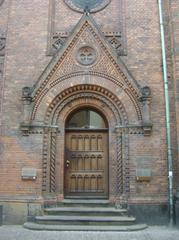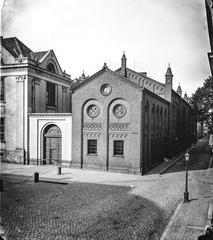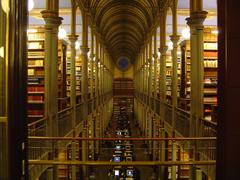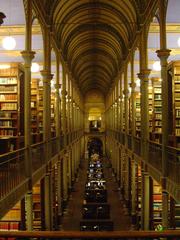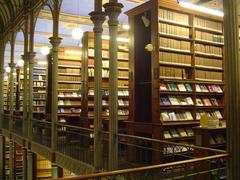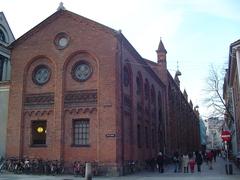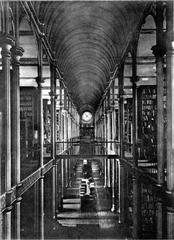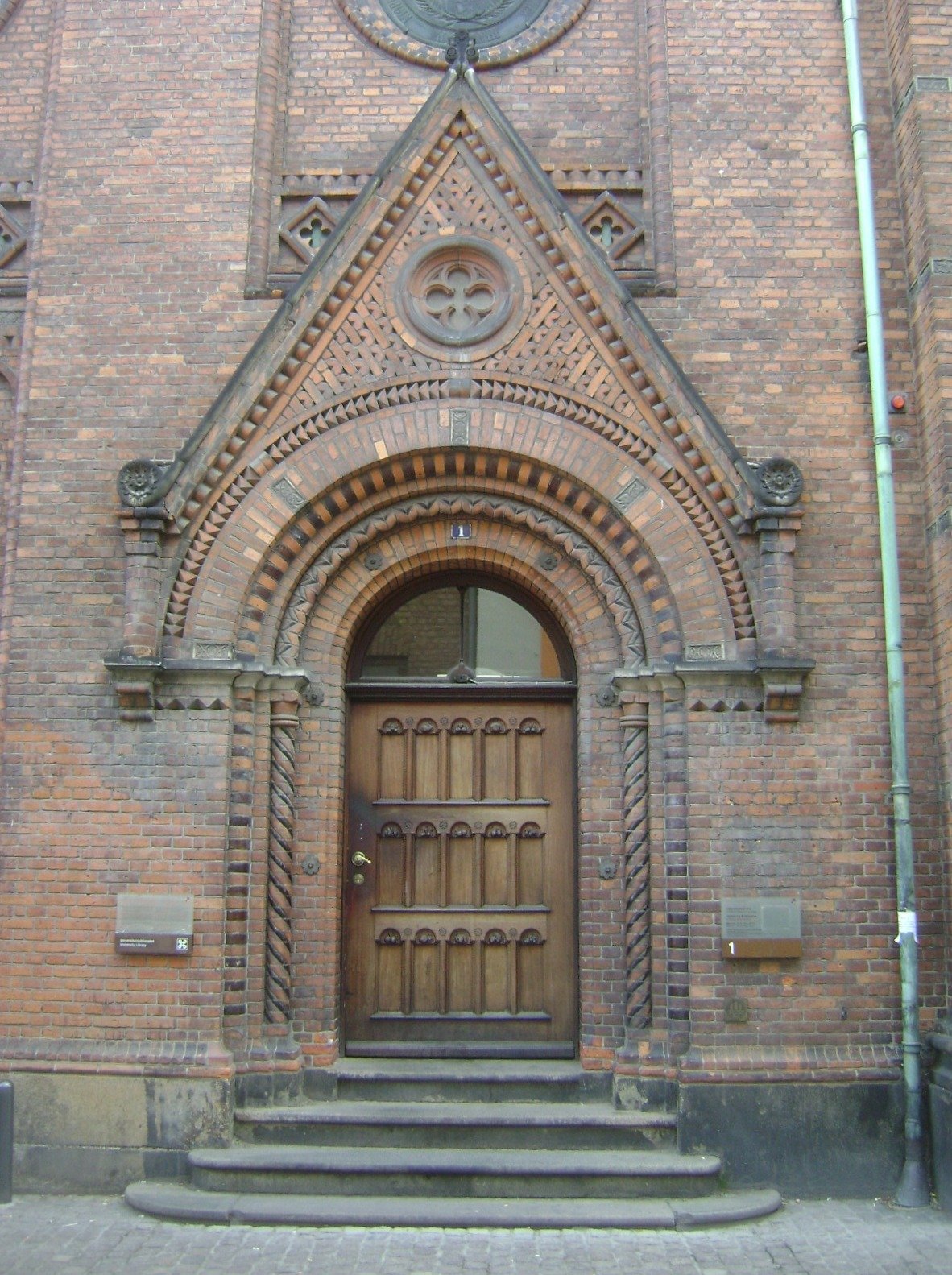
Visiting Copenhagen University Library: Guide to Hours, Tickets, and Nearby Attractions
Date: 14/06/2025
Introduction
Nestled in the heart of Copenhagen, the Copenhagen University Library stands as a testament to Denmark’s academic and cultural legacy. Established in 1482, just after the founding of the University of Copenhagen, the library has witnessed centuries of change—from its humble beginnings in the House of the Holy Ghost, to its historic tenure above Trinity Church near the iconic Round Tower, to the architectural marvel on Fiolstræde designed by Johan Daniel Herholdt in 1861. Today, the library is not only Denmark’s oldest but also a vibrant symbol of intellectual resilience, architectural ingenuity, and scholarly tradition (about.ku.dk, kub.ku.dk).
This comprehensive guide is crafted for history buffs, architecture admirers, scholars, and tourists, delivering detailed insight into the library’s history, architecture, visiting hours, ticketing, accessibility, guided tours, and nearby attractions such as the Round Tower and the Latin Quarter. Whether you seek to connect with Denmark’s academic past or enjoy a serene cultural experience, this guide will ensure your visit to the Copenhagen University Library is both memorable and enriching (kub.ku.dk, about.ku.dk).
Table of Contents
- Introduction
- Historical Overview
- Architectural and Cultural Significance
- Visiting the Copenhagen University Library
- Nearby Attractions
- Special Experiences and Events
- Frequently Asked Questions (FAQ)
- Conclusion & Recommendations
- References
Historical Overview
Early Foundation and Growth (1482–1654)
The Copenhagen University Library was established in 1482, following the University’s founding in 1479. The first collection began with a donation from Vice-Chancellor Peter Albertsen and grew alongside the university’s theological, legal, medical, and philosophical faculties (about.ku.dk). Initially housed in the House of the Holy Ghost, the library quickly became central to scholarly life in Denmark.
The Trinitatis Complex and Round Tower Era (1654–1807)
In 1654, the library relocated to the room above Trinity Church (Trinitatis Kirke), using the Round Tower (Rundetårn) as its access point. This unique arrangement embodied the union of faith and reason, although over time, the spiral ramp’s impracticality became evident (about.ku.dk).
The 1728 Fire and Recovery
The catastrophic fire of 1728 devastated much of Copenhagen and caused irreparable loss to the library’s collections, including medieval manuscripts. A resolute rebuilding effort followed, with the library gradually regaining its scholarly prominence (about.ku.dk).
The Fiolstræde Transformation (19th Century)
By the mid-1800s, the library had outgrown its space. An architectural competition in 1855—Denmark’s first for a public building—led to Johan Daniel Herholdt’s winning design for a new library on Fiolstræde, inaugurated in 1861. This building, with its red-brick Gothic Revival style and cast-iron structure, became a Danish architectural milestone (kub.ku.dk).
20th-Century Expansion and Modern Role
Through the 20th century, the library expanded, modernized, and later merged with the Royal Library (Det Kongelige Bibliotek), forming Denmark’s consolidated research library network. The Fiolstræde building, after serving as the main university library until 2009, was restored and reopened to the public in 2023 as a venue for exhibitions and cultural events (kb.dk).
Architectural and Cultural Significance
Design Competition and Herholdt’s Vision
The 1855 competition for the new library building was a pivotal moment in Danish architecture. Johan Daniel Herholdt’s winning design broke with tradition, reintroducing brick as a primary building material and pioneering the use of cast iron for structural support (kub.ku.dk, uniavisen.dk).
Gothic Revival Features and Innovations
Herholdt’s design, completed in 1861, showcases pointed arches, ribbed vaults, tall windows, and intricate brickwork reminiscent of medieval cathedrals. The use of cast-iron columns enabled a spacious, light-filled reading hall, while also improving fire resistance—a vital consideration after the 1728 fire (kub.ku.dk).
Preservation and Modern Use
After years of limited access, the Fiolstræde building was carefully restored and reopened in 2023, blending historical authenticity with modern amenities. Today, it serves as an interdisciplinary venue for exhibitions, lectures, and community events, reflecting ongoing trends in adaptive reuse of historic academic buildings (uniavisen.dk, kb.dk).
Cultural and Academic Hub
Centrally located near the Latin Quarter, the library has long been a bridge between the university and city life. Its reading rooms, events, and exhibitions continue to make it a focal point for academic and cultural engagement in Copenhagen (about.ku.dk).
Visiting the Copenhagen University Library
Location and Access
The Fiolstræde library is situated at Fiolstræde 1, 1171 København K, close to Nørreport Station and the Round Tower. It is easily accessible by foot, bicycle, metro, and several bus lines (kb.dk).
Visiting Hours and Tickets
- Opening Hours: Tuesday–Sunday, 10:00 AM–5:00 PM. Closed on Mondays and public holidays. Hours may vary on Danish public holidays—check the official website for updates.
- Admission: General entry is free. Some special exhibitions or events may require advance booking or tickets (kub.ku.dk).
Guided Tours and Events
Guided tours are offered regularly, with most in Danish and English tours available by appointment. Tours highlight the library’s architecture, history, and collections. Public lectures, debates, and exhibitions are frequently held—see the library’s website for current schedules (about.ku.dk).
Accessibility and Visitor Tips
- Accessibility: The building is wheelchair accessible, with elevators, ramps, and accessible restrooms. Staff are available to assist visitors with disabilities (kb.dk).
- Visitor Tips: For a quieter visit, arrive on weekdays or early mornings. June offers long daylight hours and mild weather, but it is peak tourist season (Nomad Epicureans).
- Photography: Allowed in public areas; flash and tripods may be restricted. Silence is expected in reading rooms.
Services and Facilities
- Study Spaces: Quiet reading rooms and collaborative areas are available for study and research.
- Events: The library regularly hosts talks, exhibitions, and participates in city-wide cultural events such as Culture Night (about.ku.dk).
- Digital Resources: Access to millions of digital and physical resources via the Royal Danish Library network (Royal Library: About).
Nearby Attractions
- Round Tower (Rundetårn): A 17th-century observatory and one of Copenhagen’s most iconic landmarks, offering panoramic city views (rundetaarn.dk).
- Trinitatis Church: Adjacent to the Round Tower, with historical ties to the university.
- Latin Quarter: Historic district filled with cafes, bookshops, and boutique stores.
- University Museums and Botanical Garden: Within walking distance for a broader cultural itinerary (about.ku.dk).
Special Experiences and Events
The library is a vibrant venue for public engagement:
- Weekly Talks and Debates: Open to all, fostering dialogue on academic and cultural topics.
- Exhibitions: Highlighting rare manuscripts, notable scholars, and historic events.
- Culture Night Participation: Annual event with special tours and activities (about.ku.dk).
- Nearby Festivals: June brings citywide celebrations—combine your library visit with Copenhagen’s festival scene (Nomad Epicureans).
Frequently Asked Questions (FAQ)
Q: What are the library’s visiting hours?
A: Tuesday–Sunday, 10:00 AM–5:00 PM. Closed Mondays and holidays. Check the official website for current schedules.
Q: Is there an admission fee?
A: No, entry is free. Some events or exhibitions may require tickets (kub.ku.dk).
Q: Are guided tours available?
A: Yes, mostly in Danish, with English tours by appointment. Book in advance (about.ku.dk).
Q: Is the library accessible for people with disabilities?
A: Yes, with ramps, elevators, and accessible restrooms (kb.dk).
Q: Can I take photographs?
A: Yes, in public areas, but no flash or tripods.
Q: What attractions are nearby?
A: The Round Tower, Trinitatis Church, Latin Quarter, Botanical Garden, and university museums.
Conclusion & Recommendations
The Copenhagen University Library is more than a repository of knowledge—it is a living monument to Denmark’s academic and architectural heritage. Its historic Fiolstræde building, innovative design, and vibrant programming make it a must-visit attraction in central Copenhagen. With free admission, guided tours, and proximity to major landmarks, the library offers a rewarding experience for anyone interested in culture, history, or architecture.
Tips:
- Plan your visit during off-peak hours for a quieter experience.
- Join a guided tour for deeper insight into the library’s story.
- Explore the nearby Round Tower and Latin Quarter to round out your cultural tour.
For up-to-date visitor information, tour schedules, and events, consult the official library website and consider downloading the Audiala app for exclusive audio tours and updates.
References
- Copenhagen University Library Official Visitor Guide
- Library History and Architecture
- Round Tower Official Website
- Royal Library: Visit Us
- University of Copenhagen History
- University of Copenhagen’s Beautiful Library Reopening
- Royal Library Timeline
- Nomad Epicureans: Visiting Copenhagen in June
- Royal Library: About
- SHL: University Library Fiolstræde
- Royal Library: Significant Holdings
